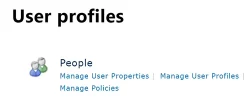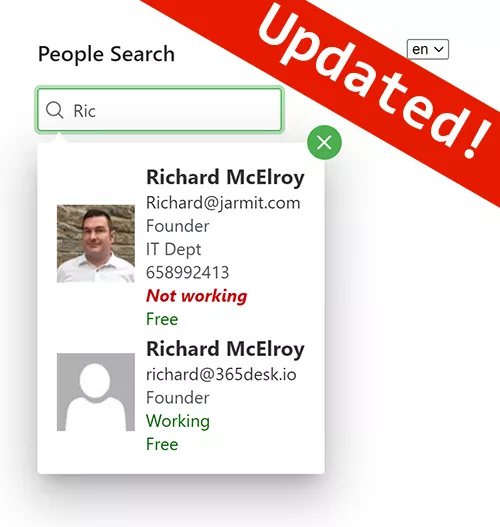
People Search
The Jarmit People Search web part allows your users to find details of people in your organization instantly.
Users input a search text and as soon as the 3rd character is added the results are shown in a pop-up as can be seen above.
The results pop-up also shows if the person is working or not and the current calendar status for each person (Free/Busy/Tentative/Out of Office).
Designed to be as small as possible, the Jarmit People Search web part can be added to the SharePoint Online home page for rapid access with minimal impact on the layout of the rest of the home page.
An efficient replacement for traditional employee directories, allowing employees to keep their own information up-to-date without any expensive and time-consuming republishing.
Multilingual support: English and Spanish

The Property Pane - updated!
Using the user profile properties imported from Active Directory, you can choose which properties you want to show in the search results.
The profile properties PreferredName, Path, PictureURL and WorkEmail are already included automatically to show the profile picture, name linked to their profile and email as a link to start a new email message.
You can add any of the other profile properties that have been mapped to a managed property in the SharePoint search admin, separating each one with a comma, for example,
JobTitle,Department,WorkPhone
Similarly, you can choose which profile properties the search will use to return results. The PreferredName property is included automatically, but you might want to add others.
Imagine the WorkPhone field in your Active Directory holds the extension number and full number for each employee’s phone. Adding it to the search properties allows users to find who is calling them from an unknown extension number while their phone is still ringing!
NEW – Filter out results and EXPERT MODE!!!
Sometimes there are accounts in your organization that aren’t people or are no longer there: system accounts, accounts belonging to employees who have left or retired, but can’t be deleted yet. You might also want to use People Search on a more restrictive level, only returning people from a specific department or office location.
You can use an active directory/Entra ID account property that is synced with the user profiles in SharePoint to filter out these accounts from the results.
Again, using mapped managed properties you can specify values for properties you want to filter out of the results separated by ‘ OR ‘, for example,
OfficeNumber:X OR OfficeNumber:Y
EXPERT MODE is another new feature that allows experts with advanced knowledge in the SharePoint Search API to specify their own ‘querytext’ parameter and obtain more complex results.
If it is specified, the values entered in ‘Properties to search’ and ‘Filter out results’ are ignored.
Use the token ‘{searchterm}’ in your querytext parameter to indicate where the web part has to replace that token with the value the user has entered.
You can adjust the number of results that will be shown up to a maximum of 10. If you require more than this, get in touch with us.
Finally, the licensing section of the property pane allows you to add your license code, which we send you after purchasing.
The ‘Apply’ button at the bottom saves your web part configuration.
How it works
User profiles and SharePoint Search
The Jarmit People Search web part uses the SharePoint search API to show results from the ‘People’ category, which indexes users and their profile properties which are imported from Active Directory.
Many of the profile properties have already been mapped to ‘managed properties’ in the search schema configuration for us by Microsoft.
But what if you have additional properties imported from Active Directory or want to add custom properties to the user profiles?
A SharePoint admin can access the user profiles and search schema configuration from the SharePoint admin center – https://tenant-admin.sharepoint.com/_layouts/15/online/AdminHome.aspx#/classicFeatures
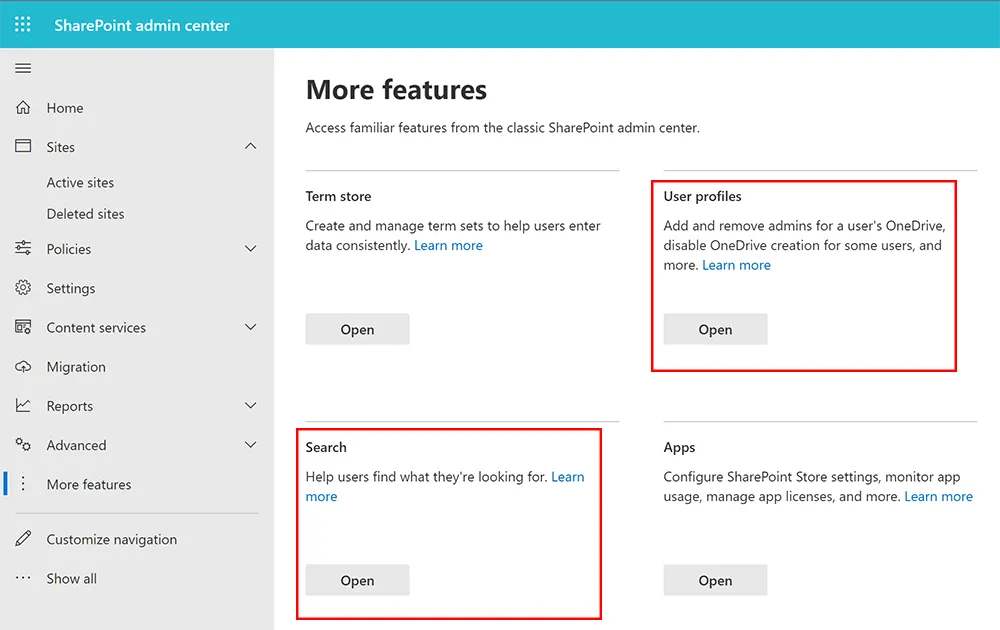
New user profile properties
Why would you want to add new user profile properties?
Maybe some people in your organization have an emergency phone number or additional extension numbers you want to be able to find quickly.
Whatever the reason, from the user profiles we can manage which properties the user profiles have and add new ones. These new properties will be crawled as long as the ‘Indexed’ checkbox is selected.
If you want a new property to be available to show to other users, you must set the ‘Default Privacy Setting’ to ‘Everyone’.
To be able to update the property, you can check the ‘Allow users to edit values for this property’ to allow users to edit this property directly.
If you don’t want users to edit a new property, leave this setting unchecked.
To be able to edit the property in the ‘Edit Details’ page of the user profiles admin page, check the ‘Show on the Edit Details page’ setting.
Indexing, crawled and managed properties
New profile properties may take a while to appear in the SharePoint search schema, and they will only appear if there is data in them in at least one user profile.
Unfortunately, unlike SharePoint on-premise, there is no means to manually trigger user profile re-indexation. In SharePoint Online sites, we have a button to manually re-index a list or library.
Microsoft, it would be really nice if you could add a button to the SharePoint Search admin to allow us to initiate a re-indexation on a specific result source. That wouldn’t be hard now, would it?
To review crawled properties and edit and create new managed properties (which are what the SharePoint search API uses) we follow the ‘Manage Search Schema’ link.
Selecting ‘Crawled Properties’, then filtering by the ‘People’ category, we see all the properties SharePoint Search has indexed from the user profiles. The list is paged, showing the first 50 results. The link to go to the next page of results is slightly hidden in the top right-hand corner.
One standard profile property has a special treatment in the Jarmit People Search web part: SPS-Birthday.
If you want to include this property in the pop-up search results, you first need to map the crawled property to one of the refinable date managed properties – in the example here, we have mapped it to ‘RefinableDate00(Date and Time)’.
Then, in the ‘Managed Properties’ section, you can search for the refinable managed property used and add an alias ‘Birthday’ to it.
In the Jarmit People Search web part, the property ‘Birthday’ will be shown as a date without the year, for example: 8 of April.
You can use this same procedure to create new custom user profile properties and map their crawled property to an unused refinable managed property, give it an alias and have it display in the Jarmit People Search web part results pop-up.
Working/Not working and Calendar status
Two additional values appear in the search results pop-up: Working/Not working and the users’ calendar status.
When you add the Jarmit People Search web part to a site for the first time, it creates two hidden SharePoint lists automatically: Jarmit People Search Admins and Jarmit People Search Absent.
The user who adds the web part to a SharePoint page automatically becomes an admin for the web part in that site and will see the administrator links below the search text box that take you to the two lists.
The Jarmit People Search Administrators list allows the current administrator to add additional administrators, so they can access and manage the Jarmit People Search Absent list.
The Jarmit People Search Absent list is where an admin can add items to the list to indicate a certain user is not working from a start date till the end date. This might be because the person is on vacation, on sick leave, maternity leave, whatever. The reason is not important, and indeed might be private, so this list only indicates that these users are not working between the start and end dates.
If the end date for a person being absent is not known, just add an arbitrary date in the future, and when the real end date is known, it can be updated.
The Jarmit People Search Absent list can be maintained manually by administrators, for example the human resources department.
Alternatively, if your organization has a system for managing employees who are absent, it may be possible to link that system to automatically keep the Jarmit People Search Absent list updated automatically via the standard SharePoint REST API.
If you need help linking external systems to the absent list or would like the Jarmit People Search web part to be able to access them directly through their own API’s, let us know.
Calendar status for each person in the results pop-up is retrieved via the Graph API and only shows the status of any calendar event in the next 30 minutes – no details of calendar events are shown for privacy. Possible values are Free, Busy, Tentative and Out of Office.
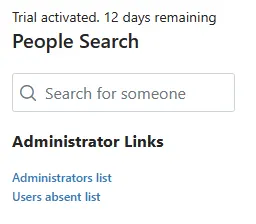
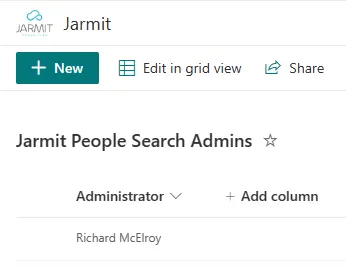
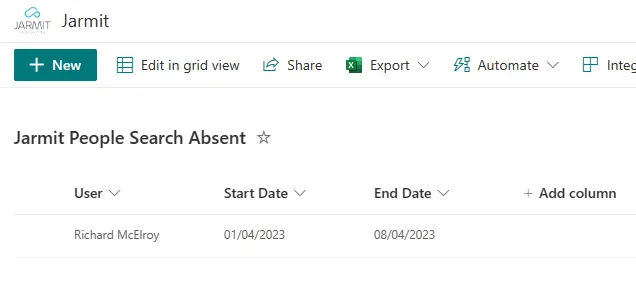
Installation instructions
Fill out the registration form below and click the button to download a zip file containing the .sppkg SPFx solution file.
This solution will only work in SharePoint Online. If you are interested in a version for SharePoint 2016/2019/Subscription Edition, please let us know.
If you have installed any previous versions of this solution, you can download the latest one and overwrite the version already installed. Your license code will still be valid.
If you wish to deploy this solution to your entire SharePoint Online environment, you need to add this solution to your tenant app catalog.
To do this, you must be a SharePoint Administrator or a Global Administrator.
If you do not yet have a tenant app catalog (usually created at the URL https://your-tenant.sharepoint.com/sites/appcatalog) you can create one easily.
- Open your SharePoint administration site (https://your-tenant-admin.sharepoint.com/)
- In the left sidebar, select ‘More features’
- Then locate the section ‘Apps’ and select ‘Open’.
This will start the automatic creation of the tenant app catalog if it does not exist.
You can also install this solution in a site level app catalog if you only want it to be available in specific SharePoint sites.
For more information on how to create site collection app catalogs and how to use them, please read this Microsoft article.
When you add the .sppkg file to the app catalog, you will see a deployment dialog. To make the Jarmit People Search web part directly available to all SharePoint sites, you can check the ‘Make this solution available to all sites in the organization’ setting.
Before the web part can be used, you must first approve the solution permissions required to be able to read users calendars and retrieve the status.
Open the API access page from the link in the SharePoint admin center below the ‘Advanced’ menu or open the URL https://tenant-admin.sharepoint.com/_layouts/15/online/AdminHome.aspx#/webApiPermissionManagement.
If the permission for Graph API to read users calendars has not previously been given, it will appear in the ‘Pending requests’ section. Select and approve it, and you can then start to use the web part.
If you don’t check the ‘Make this solution available to all sites in the organization’ setting during deployment, you can add the web part to individual SharePoint sites by going to the site contents page, and select New -> App.
The new modern experience will show a list of solutions you can add to the site. Click the ‘Add’ button underneath the Jarmit People Search solution.
It will take a few seconds for SharePoint to add the web part to the site. Once it appears in the site contents page, you can add it to a SharePoint page.
While editing a SharePoint page, you can find the Jarmit People Search web part in the toolbox in the ‘Advanced’ section.
When you add the web part to a page, you start a 14 day fully functional trial period. After 14 days, the web part will cease to work and display a ‘trial finished’ message.
After purchasing a license, you can edit the page, open the web part property pane and copy the license code into the text box to activate the license.
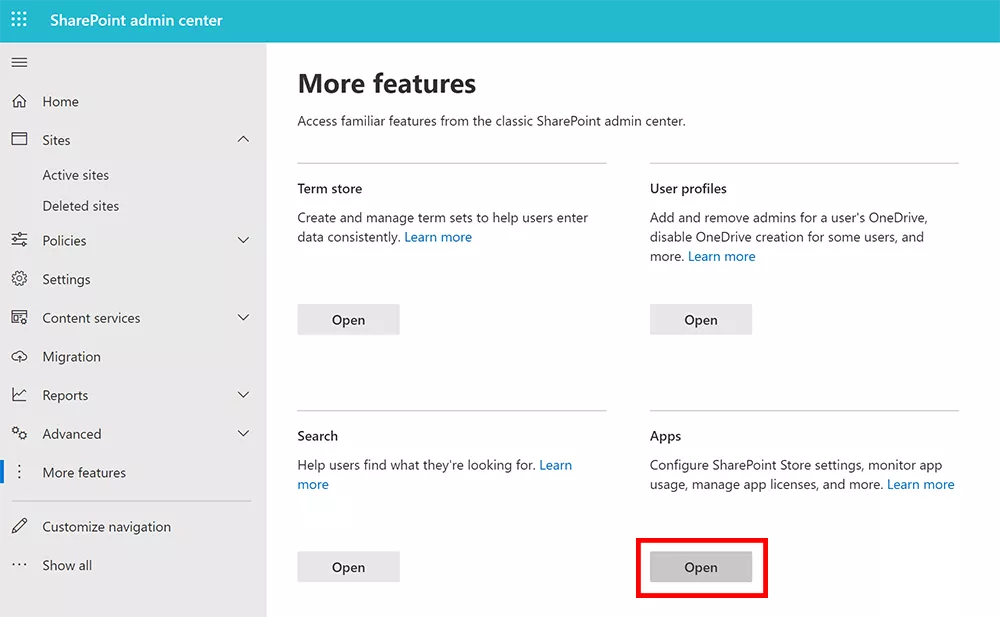
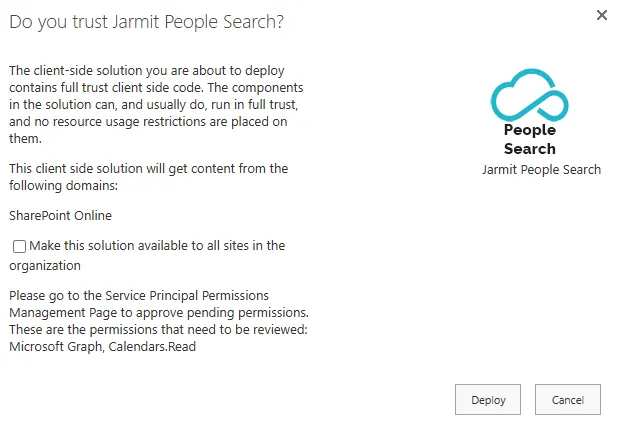
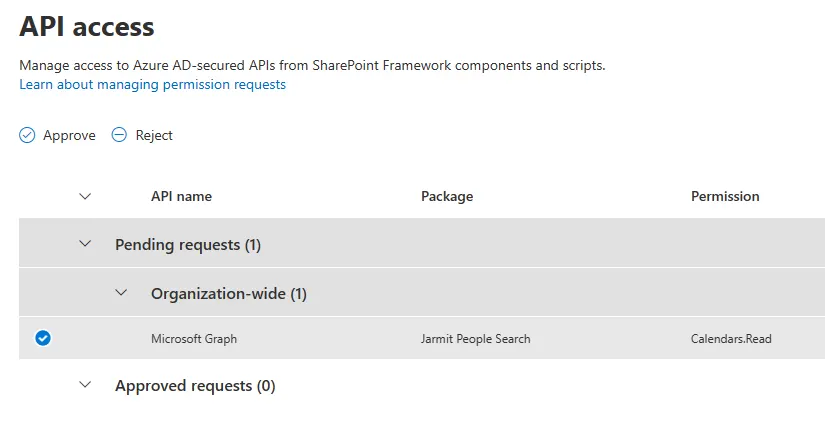
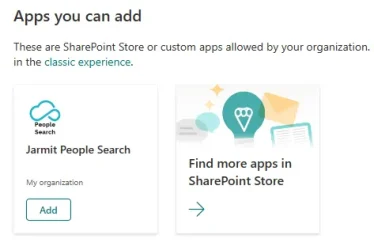
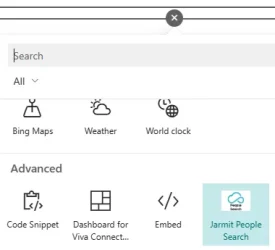
Pricing
(<50 employees)
- Unlimited use in 1 Microsoft 365 tenant
- Installation and 1st configuration included
- Free updates
- Email support
- 1 free lifetime subscription to 365Desk.io
(50-499 employees)
- Unlimited use in up to 2 Microsoft 365 tenants owned by the business
- Installation and 1st configuration included
- Free updates
- Email support
- 1 free lifetime subscription to 365Desk.io
(>500 employees)
- Unlimited use in up to 5 Microsoft 365 tenants owned by the business
- Installation and 1st configuration included
- Free updates
- Email support
- 1 free lifetime subscription to 365Desk.io
Registration Form
To download the Jarmit People Search web part, please fill out the following form.
Use your Microsoft 365 email to register and receive 1 free lifetime subscription to 365Desk.io (limit 1 per Microsoft 365 tenant).

